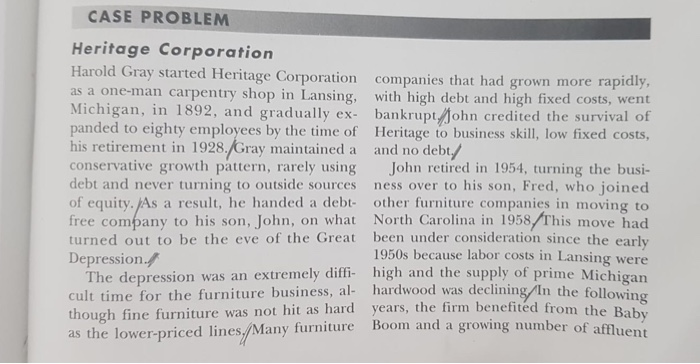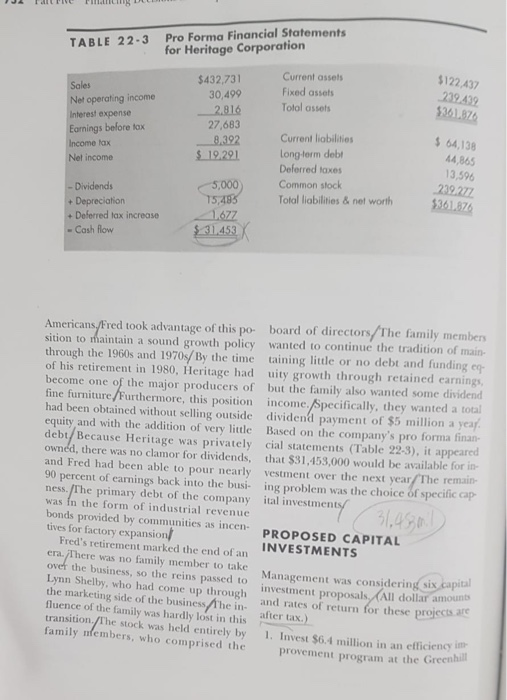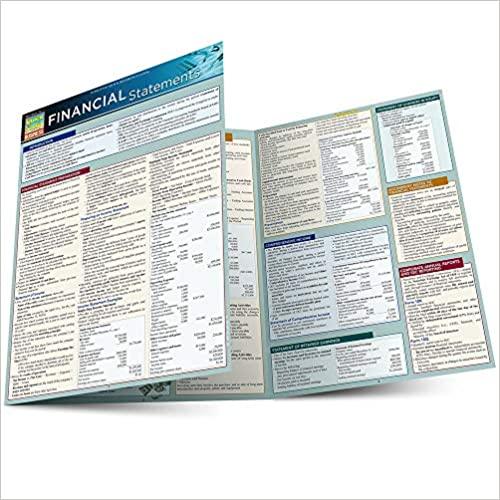PLEASE ANSWER THE CASE QUESTIONS
THANK YOU
CASE PROBLEM Heritage Corporation Harold Gray started Heritage Corporation companies that had grown more rapidly, as a one-man carpentry shop in Lansing, with high debt and high fixed costs, went Michigan, in 1892, and gradually ex- bankrupt. John credited the survival of panded to eighty employees by the time of Heritage to business skill, low fixed costs, his retirement in 1928./Gray maintained a and no debt, conservative growth pattern, rarely using John retired in 1954, turning the busi- debt and never turning to outside sources ness over to his son, Fred, who joined of equity. As a result, he handed a debt- other furniture companies in moving to free company to his son, John, on what North Carolina in 1958/This move had turned out to be the eve of the Great been under consideration since the early 1950s because labor costs in Lansing were Depression. The depression was an extremely diffi- high and the supply of prime Michigan cult time for the furniture business, al- hardwood was declining. In the followin though fine furniture was not hit as hard years, the firm benefited from the Babe as the lower-priced lines./Many furniture Boom and a growing number of aff L TIP PILIS UL TABLE 22-3 Pro Forma Financial Statements for Heritage Corporation $432,731 Current assets Fixed assets Tolol assets $122.437 239.439 30,499 $361,874 Sales Net operating income Interest expense Earnings before fox Income tax Nel income 2.816 27,683 8.392 $ 19.291 Current liabilities Long-term deb Deferred taxes Common stock Total liabilities & net worth $ 64,138 44,865 13,596 239.27 $361,876 - Dividends + Depreciation Deferred tax increase - Cash flow 5,000 75,483 1.677 $ 31,453 Americans, Fred took advantage of this po- board of directors/The family members sition to maintain a sound growth policy wanted to continue the tradition of main- through the 1960s and 1970s/By the time taining little or no debt and funding cq- of his retirement in 1980, Heritage had uity growth through retained earnings, become one of the major producers of but the family also wanted some dividend fine furniture/Furthermore, this position income. Specifically, they wanted a total had been obtained without selling outside dividend payment of $5 million a year equity and with the addition of very little Based on the company's pro forma finan debt Because Heritage was privately cial statements (Table 22-3), it appeared owned, there was no clamor for dividends, that $31,453,000 would be available for in- and Fred had been able to pour nearly vestment over the next year/The remain 90 percent of earnings back into the busi- ing problem was the choice of specific cap ness. The primary debt of the company ital investments was in the form of industrial revenue bonds provided by communities as incen. tives for factory expansion PROPOSED CAPITAL Fred's retirement marked the end of an INVESTMENTS era. There was no family member to take over the business, so the reins passed to Management was considering six capital Lynn Shelby, who had come up through investment proposals. All dollar amounts the marketing side of the business the in- and rates of return for these projects fluence of the family was hardly lost in this after tax.) transition. The stock was held entirely by 1. Invest $6.4 million in an efficiency family members, who comprised the provement program at the Greco pany Chapter 22 Capital Rationing 753 lant. The efficiency program was ex- cted to generate after tax cash flows 6. Invest in lvear U.S. government secte of $1,364,000 at the end of each year rities yielding 7.1 percent after lax, or for 10 years. buy 5-year U.S. government securities 1,364 Mil Buy a small, specialty furniture com- yielding 8.9 percent after tax. any for $23.6 million. The company Due to uncertainty in the business, Her- would complement Heritage's existing itage generally used a 10-year planning products, and marketing could be horizon for evaluating new investments. handled by Heritage's existing sales However, exceptions were made in certain organization. Cash flow was expected cases, such as purchase of timber stands It to be $2.58 million at the end of the was impossible to evaluate these invest- first year, and was expected to grow at ments unless a longer life was considered (3 percent a year thereafter. Heritage had a weighted average cost of 3. Build a new mill at Bernwood. The capital of approximately 13 percent. project would require 2 years for com Shelby knew that nothing could be pletion. Outlays of $5.2 million would done about the board's capital rationing be required immediately and another policy immediately, but saw modification 85.8 million would be required in 1 of this policy as an important objective. year. Operation would begin in year 3. Shelby decided to work under the assump- Cash flows would then be $2.8 million tion that it would take 5 years to persuade at the end of each year for 10 years, the board to change its policy. Capital ra- with an estimated terminal value of tioning would be eliminated if the policy $5 million after tax. was changed, although the cost of capital 4. Invest $3 million in a new design and was not expected to change significantly. development center. Operating costs for the center would then be $460,000 Case Questions at the end of each year. While im- 1. What combination of investments will proved designs were expected, there maximize shareholder wealth? was no identifiable cash flow benefit. 2. What combination of investments 5. Purchase tracts of young hardwood would maximize shareholder wealth if for $400 an acre. Maintenance costs no investments earning more than the would be $12 an acre, payable at the weighted average cost of capital would end of each year, for 15 years. The be available after the initial invest- hardwood could be harvested and ment decision? sold to produce cash flow of 100 an 3. Assume existing investment opportu- acre. Immediately after harvest, the nities other than the acquisition can land would have a value of $200 an be postponed until the end of the acre. At least 200,000 acres of young 5-year rationing period, but no other hardwood were available, in plots of investments with returns above the almost every possible size. Timberland weighted average cost of capital will be is easily bought and sold at any state of available. Identify the investment choices and timing that will maximize maturity to provide the owners the same rate of return regardless of how shareholder wealth. long it is held CASE PROBLEM Heritage Corporation Harold Gray started Heritage Corporation companies that had grown more rapidly, as a one-man carpentry shop in Lansing, with high debt and high fixed costs, went Michigan, in 1892, and gradually ex- bankrupt. John credited the survival of panded to eighty employees by the time of Heritage to business skill, low fixed costs, his retirement in 1928./Gray maintained a and no debt, conservative growth pattern, rarely using John retired in 1954, turning the busi- debt and never turning to outside sources ness over to his son, Fred, who joined of equity. As a result, he handed a debt- other furniture companies in moving to free company to his son, John, on what North Carolina in 1958/This move had turned out to be the eve of the Great been under consideration since the early 1950s because labor costs in Lansing were Depression. The depression was an extremely diffi- high and the supply of prime Michigan cult time for the furniture business, al- hardwood was declining. In the followin though fine furniture was not hit as hard years, the firm benefited from the Babe as the lower-priced lines./Many furniture Boom and a growing number of aff L TIP PILIS UL TABLE 22-3 Pro Forma Financial Statements for Heritage Corporation $432,731 Current assets Fixed assets Tolol assets $122.437 239.439 30,499 $361,874 Sales Net operating income Interest expense Earnings before fox Income tax Nel income 2.816 27,683 8.392 $ 19.291 Current liabilities Long-term deb Deferred taxes Common stock Total liabilities & net worth $ 64,138 44,865 13,596 239.27 $361,876 - Dividends + Depreciation Deferred tax increase - Cash flow 5,000 75,483 1.677 $ 31,453 Americans, Fred took advantage of this po- board of directors/The family members sition to maintain a sound growth policy wanted to continue the tradition of main- through the 1960s and 1970s/By the time taining little or no debt and funding cq- of his retirement in 1980, Heritage had uity growth through retained earnings, become one of the major producers of but the family also wanted some dividend fine furniture/Furthermore, this position income. Specifically, they wanted a total had been obtained without selling outside dividend payment of $5 million a year equity and with the addition of very little Based on the company's pro forma finan debt Because Heritage was privately cial statements (Table 22-3), it appeared owned, there was no clamor for dividends, that $31,453,000 would be available for in- and Fred had been able to pour nearly vestment over the next year/The remain 90 percent of earnings back into the busi- ing problem was the choice of specific cap ness. The primary debt of the company ital investments was in the form of industrial revenue bonds provided by communities as incen. tives for factory expansion PROPOSED CAPITAL Fred's retirement marked the end of an INVESTMENTS era. There was no family member to take over the business, so the reins passed to Management was considering six capital Lynn Shelby, who had come up through investment proposals. All dollar amounts the marketing side of the business the in- and rates of return for these projects fluence of the family was hardly lost in this after tax.) transition. The stock was held entirely by 1. Invest $6.4 million in an efficiency family members, who comprised the provement program at the Greco pany Chapter 22 Capital Rationing 753 lant. The efficiency program was ex- cted to generate after tax cash flows 6. Invest in lvear U.S. government secte of $1,364,000 at the end of each year rities yielding 7.1 percent after lax, or for 10 years. buy 5-year U.S. government securities 1,364 Mil Buy a small, specialty furniture com- yielding 8.9 percent after tax. any for $23.6 million. The company Due to uncertainty in the business, Her- would complement Heritage's existing itage generally used a 10-year planning products, and marketing could be horizon for evaluating new investments. handled by Heritage's existing sales However, exceptions were made in certain organization. Cash flow was expected cases, such as purchase of timber stands It to be $2.58 million at the end of the was impossible to evaluate these invest- first year, and was expected to grow at ments unless a longer life was considered (3 percent a year thereafter. Heritage had a weighted average cost of 3. Build a new mill at Bernwood. The capital of approximately 13 percent. project would require 2 years for com Shelby knew that nothing could be pletion. Outlays of $5.2 million would done about the board's capital rationing be required immediately and another policy immediately, but saw modification 85.8 million would be required in 1 of this policy as an important objective. year. Operation would begin in year 3. Shelby decided to work under the assump- Cash flows would then be $2.8 million tion that it would take 5 years to persuade at the end of each year for 10 years, the board to change its policy. Capital ra- with an estimated terminal value of tioning would be eliminated if the policy $5 million after tax. was changed, although the cost of capital 4. Invest $3 million in a new design and was not expected to change significantly. development center. Operating costs for the center would then be $460,000 Case Questions at the end of each year. While im- 1. What combination of investments will proved designs were expected, there maximize shareholder wealth? was no identifiable cash flow benefit. 2. What combination of investments 5. Purchase tracts of young hardwood would maximize shareholder wealth if for $400 an acre. Maintenance costs no investments earning more than the would be $12 an acre, payable at the weighted average cost of capital would end of each year, for 15 years. The be available after the initial invest- hardwood could be harvested and ment decision? sold to produce cash flow of 100 an 3. Assume existing investment opportu- acre. Immediately after harvest, the nities other than the acquisition can land would have a value of $200 an be postponed until the end of the acre. At least 200,000 acres of young 5-year rationing period, but no other hardwood were available, in plots of investments with returns above the almost every possible size. Timberland weighted average cost of capital will be is easily bought and sold at any state of available. Identify the investment choices and timing that will maximize maturity to provide the owners the same rate of return regardless of how shareholder wealth. long it is held









